 When we consider the number of stressors wean pigs face, it’s no surprise that starting pigs in the nursery can be challenging. So, the question becomes, what can we do to help?
When we consider the number of stressors wean pigs face, it’s no surprise that starting pigs in the nursery can be challenging. So, the question becomes, what can we do to help?
There are several practical ways to reduce stress, encourage pen exploration, and promote earlier feed intake to ensure a successful weaning transition.
CREEP FEEDING
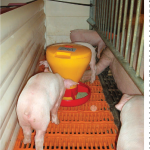 Creep feeding litters during the suckling period is one strategy that helps acclimate pigs to solid feed before weaning. Creep feeding should be considered for older wean-age pigs (> 21 days), as litter intake remains relatively low up until approximately 20 days of age. As wean ages across PIPESTONE managed sow farms have increased, creep feeding strategies are being evaluated through internal research trials.
Creep feeding litters during the suckling period is one strategy that helps acclimate pigs to solid feed before weaning. Creep feeding should be considered for older wean-age pigs (> 21 days), as litter intake remains relatively low up until approximately 20 days of age. As wean ages across PIPESTONE managed sow farms have increased, creep feeding strategies are being evaluated through internal research trials.
BARN PREPARATION
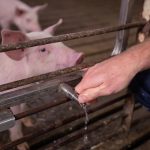 Making sure nipple waterers are turned on and cup waterers are full, feed is available in feeders, barn temperature and ventilation are at the appropriate set points, mats are in place, and brooders are lit are all crucial first steps before pigs arrive at the nursery or wean-to-finish site.
Making sure nipple waterers are turned on and cup waterers are full, feed is available in feeders, barn temperature and ventilation are at the appropriate set points, mats are in place, and brooders are lit are all crucial first steps before pigs arrive at the nursery or wean-to-finish site.
SORTING STRATEGIES
 Upon arrival, it is recommended to sort lightweight pigs (approximately 10% of the population) into uniform body weight groups and the rest of the population into mixed groups. This reduces initial aggression in heavyweight pigs and provides greater feeding opportunities for lightweight pigs.
Upon arrival, it is recommended to sort lightweight pigs (approximately 10% of the population) into uniform body weight groups and the rest of the population into mixed groups. This reduces initial aggression in heavyweight pigs and provides greater feeding opportunities for lightweight pigs.
NURSERY REEDING PROGRAM
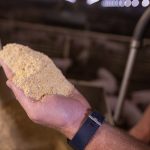 Providing an appropriate phase feeding program to match the nutrient requirements and digestive abilities of weaned pigs is critical. Dietary phases are typically matched with the age and/or body weight of pigs at weaning, such that older, heavier weaned pigs (≥ 14 lbs.) can receive less total nursery feed compared to younger, lighter pigs. This is because nursery diets are often more expensive due to diet form and complexity.
Providing an appropriate phase feeding program to match the nutrient requirements and digestive abilities of weaned pigs is critical. Dietary phases are typically matched with the age and/or body weight of pigs at weaning, such that older, heavier weaned pigs (≥ 14 lbs.) can receive less total nursery feed compared to younger, lighter pigs. This is because nursery diets are often more expensive due to diet form and complexity.
MAT FEEDING
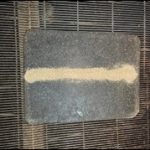 Mat feeding is used to stimulate group feeding behavior like suckling and has been shown to reduce fallout rates. Mat feed should be provided three to four times per day for up to 10 days post-placement depending on pig age at weaning, with younger pigs mat fed longer. Despite age, all pigs should be mat fed. This can be accomplished by taking one to two handfuls of feed from the back of the feeder and applying it in a straight line directly onto floor mats when you first get to the barn, prior to walking pens. Then repeating this process as you walk pens and again before leaving the barn. Mats should be located close to the feeder with the goal of driving pigs toward the feeder as frequently as possible.
Mat feeding is used to stimulate group feeding behavior like suckling and has been shown to reduce fallout rates. Mat feed should be provided three to four times per day for up to 10 days post-placement depending on pig age at weaning, with younger pigs mat fed longer. Despite age, all pigs should be mat fed. This can be accomplished by taking one to two handfuls of feed from the back of the feeder and applying it in a straight line directly onto floor mats when you first get to the barn, prior to walking pens. Then repeating this process as you walk pens and again before leaving the barn. Mats should be located close to the feeder with the goal of driving pigs toward the feeder as frequently as possible.
GRUEL FEEDING
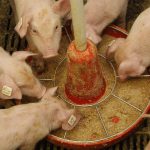 In addition to mat feeding, pens of small pigs should receive gruel three to four times per day up to 10d postplacement. Gruel feeding is accomplished by adding a small amount of water and feed to either round rotecna bowls or trough feeders, starting with a more liquid mixture (think oatmeal consistency) and gradually transitioning to a dry mixture over time. The key with gruel is to not overfill feeders so that feed begins to spoil if not fully consumed. Hence, pigs should consume all gruel within 30 minutes of mixing. Another thing to consider is how and where gruel is being mixed – take care and prevent excess water from making the pen wet and chilling pigs.
In addition to mat feeding, pens of small pigs should receive gruel three to four times per day up to 10d postplacement. Gruel feeding is accomplished by adding a small amount of water and feed to either round rotecna bowls or trough feeders, starting with a more liquid mixture (think oatmeal consistency) and gradually transitioning to a dry mixture over time. The key with gruel is to not overfill feeders so that feed begins to spoil if not fully consumed. Hence, pigs should consume all gruel within 30 minutes of mixing. Another thing to consider is how and where gruel is being mixed – take care and prevent excess water from making the pen wet and chilling pigs.
EFFECT OF MAT FEEDING ON THE MORTALITY AND REMOVAL RATE OF PIGS POST-WEANING

A total of 10,795 mixed sex pigs were used in four experiments to determine the effect of mat feeding the first 6 to 10d post-weaning on nursery mortality and removal rates.
HOSPITAL PENS
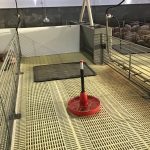
Hospital pens should be equipped with a brooder to keep pigs warm and dry. Limiting drafts to these pens is also important. When considering the location of hospital pens in relation to wall fans and ceiling inlets, it’s typically recommended to place pens of at-risk pigs in the center of the room, away from outside walls. In some cases, this may still require a solid partition to be added to the fence lines of pens to prevent excessive drafts. Mat and gruel feeding this population of pigs for an extended period is necessary until full bellies are observed and pigs can be graduated to recovery pens. The target for caretakers should be to graduate 60% of pigs within five days of placement into hospital pens. Each of these management strategies is only successful when available to the pig, thus it’s important to make sure feed, water, mats, and brooders are all located in a central area so that pigs do not have to travel far to access what they need. Frequent observations of hospital pens throughout the day should also be top priority, with caretakers focused on getting pigs up and moving them toward feed and water. To set your pigs up for future success, it has been well established that the 3 to 10 days post-weaning are crucial. Aside from environment and health, the most important, and frankly, most overlooked component of wean pig care is the act of caretakers getting into pens. Executing the strategies above will create added opportunities for caretakers to get pigs up and observe them several times each day. Consistent observation is one of the greatest tools we can utilize to help the weaned pig.
Article by Madie Wensley
Nutritionist, Pipestone Nutrition
